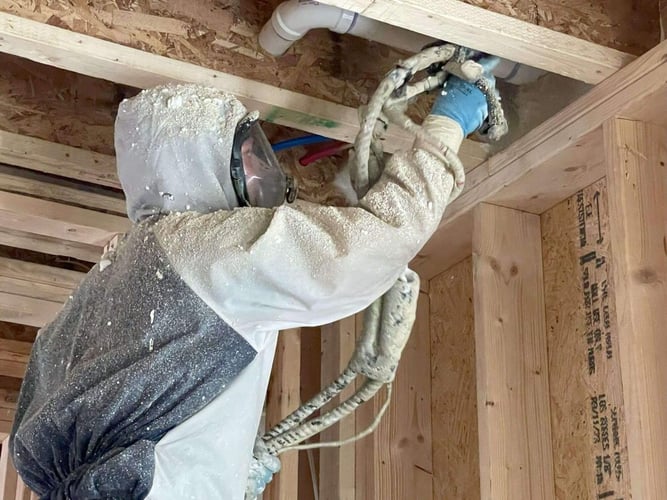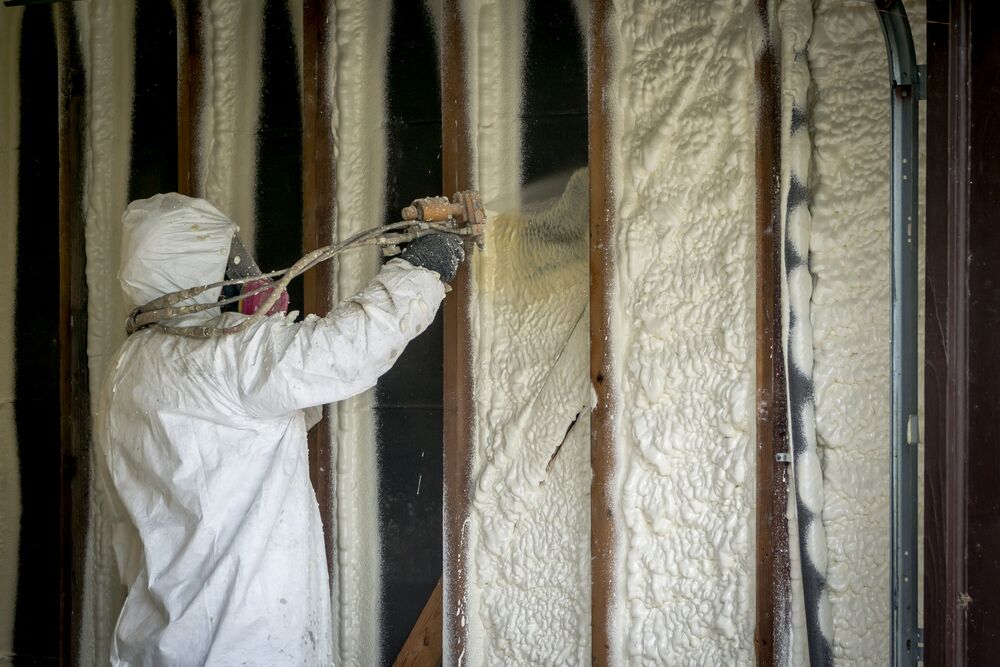Contrasting Spray Foam to Standard Insulation: Which Is Better?
Contrasting Spray Foam to Standard Insulation: Which Is Better?
Blog Article
Spray Foam: The Ultimate Option for Air Sealing and Insulation
Spray foam insulation has become a leading option for effective air securing and thermal insulation, providing an one-of-a-kind combination of residential properties that establish it aside from typical methods. Its capacity to expand and fill up voids makes it particularly effective in stopping air leak, which can significantly affect power efficiency. Nevertheless, recognizing the complete range of its advantages, installment procedures, and comparisons with various other insulation types is essential for making notified choices. As we discover these elements, the effects for both brand-new constructions and retrofits become increasingly significant. What factors should influence your selection?
What Is Spray Foam?
Spray foam is a versatile insulation material that incorporates the principles of air securing and thermal resistance to boost energy effectiveness in structures. Composed largely of polyurethane or other similar compounds, spray foam is applied as a fluid that increases upon call with surface areas, creating a strong, continuous layer of insulation. This distinct residential property permits it to load spaces, fractures, and gaps that traditional insulation products may overlook, supplying an exceptional air seal.
There are 2 primary sorts of spray foam: open-cell and closed-cell. Open-cell spray foam is lighter and a lot more flexible, using outstanding sound absorption and a lower R-value per inch - Spray Foam. On the other hand, closed-cell spray foam is denser, supplying a higher R-value, moisture resistance, and included structural honesty to constructing parts
The application process usually entails specialized tools, guaranteeing a seamless application that sticks to numerous substratums, consisting of concrete, metal, and timber. This flexibility makes spray foam suitable for both brand-new constructions and retrofitting existing frameworks. Its capability to develop a closed obstacle considerably adds to lowering energy usage and enhancing interior air high quality, thereby making it a recommended choice amongst home owners and contractors alike.
Advantages of Spray Foam Insulation
Among one of the most significant advantages of spray foam insulation is its exceptional capability to create a constant air obstacle, which properly decreases power loss. Unlike standard insulation materials, spray foam increases to load voids and cracks, making sure that air leak is considerably lowered. This characteristic not only boosts power efficiency yet additionally brings about reduce energy costs in time.
Additionally, spray foam insulation provides superior thermal resistance, contributing to an extra stable indoor atmosphere. Its high R-value per inch permits reliable insulation in confined rooms, making it ideal for attics, walls, and crawl rooms. Additionally, the moisture-resistant buildings of spray foam assistance stop mold and mildew and mildew growth, promoting much healthier living problems.
One more essential advantage of spray foam insulation is its sound-dampening high qualities (Spray Foam). It properly minimizes sound transmission between spaces, developing a quieter and more comfy home setting. The longevity of spray foam also stands out, as it does not sag or clear up with time, keeping its efficiency throughout its life-span
How Spray Foam Functions
Recognizing just how spray foam insulation works is vital for appreciating its efficiency in air sealing and thermal resistance. Spray foam insulation contains two key parts: isocyanate and polyol resin. When these components are combined, they go through a chemical response that causes the material to expand quickly, creating a dense foam that fills up cavities, voids, and splits.
As the foam increases, it complies with surface areas, developing an impermeable seal that considerably decreases air seepage. This particular makes spray foam insulation highly efficient at protecting against drafts and wetness infiltration, which can cause energy loss and damage gradually. Additionally, the closed-cell variant of spray foam supplies exceptional thermal resistance because of its rigid structure, properly minimizing warm transfer.
The unique residential or commercial properties of spray foam allow it to adapt irregular surface areas, making sure detailed protection and a smooth barrier. Because of this, spray foam insulation not only enhances energy efficiency but also contributes to boosted interior air quality by decreasing the build-up of contaminants and irritants. Inevitably, recognizing the technicians behind spray foam underscores its function as a premium selection for insulation and air sealing in both commercial and household applications.
Installation Refine Review

Prior to installment, the room should be appropriately cleaned up and prepped, guaranteeing that surfaces are totally free from dirt, dampness, and particles. Due to the fact that impurities can endanger bond and total performance, this action is crucial. When the area is prepared, the application involves blending the two components of the spray foam, which broadens upon contact and our website loads spaces successfully.
Trained specialists must carry out the installment, using specialized tools to make sure consistent insurance coverage and optimum thickness. Safety and security precautions, including wearing protective gear and ensuring proper ventilation, are imperative throughout this procedure. After application, the foam normally remedies swiftly, developing a solid obstacle that boosts power effectiveness.
Contrasting Spray Foam to Standard Insulation
When reviewing insulation options, spray foam insulation stands out in comparison to traditional products such as fiberglass and cellulose. Among the primary advantages of spray foam is its premium air securing abilities. like this Unlike fiberglass and cellulose, which can allow air seepage, spray foam increases upon application, loading spaces and gaps to develop a closed seal. This leads to boosted power effectiveness, as less warmed or cooled air leaves the home, bring about reduced utility bills.
Additionally, spray foam provides a greater R-value per inch than traditional insulation kinds, offering even more effective thermal resistance in a thinner account. This particular is especially advantageous in spaces with restricted cavity deepness. Spray foam is immune to moisture and mold and mildew development, which can be a substantial problem with cellulose useful source and fiberglass, particularly in humid settings.
Nevertheless, spray foam insulation generally lugs a greater upfront price than its conventional counterparts. Home owners must weigh this first investment versus lasting energy savings and efficiency benefits. Ultimately, while both insulation types offer their purpose, spray foam emerges as an advanced solution for modern-day insulation requirements, particularly in regards to air securing and thermal efficiency.

Verdict
In summary, spray foam insulation represents a highly efficient solution for accomplishing ideal air sealing and thermal resistance. Its distinct homes, including moisture resistance and audio dampening, make it suitable for numerous applications in both brand-new constructions and retrofitting jobs (Spray Foam). Although the initial costs might be greater contrasted to conventional insulation products, the long-lasting benefits, such as considerable power cost savings and enhanced indoor air high quality, warrant the investment and highlight its value in contemporary structure practices.
Spray foam insulation has arised as a leading option for effective air securing and thermal insulation, using a distinct combination of properties that establish it apart from standard methods.Spray foam is a functional insulation material that incorporates the principles of air securing and thermal resistance to enhance power efficiency in structures.When assessing insulation options, spray foam insulation stands out in contrast to conventional products such as fiberglass and cellulose. Eventually, while both insulation kinds serve their function, spray foam arises as a more innovative service for contemporary insulation needs, especially in terms of air securing and thermal efficiency.
In summary, spray foam insulation stands for a highly efficient service for attaining optimal air sealing and thermal resistance.
Report this page